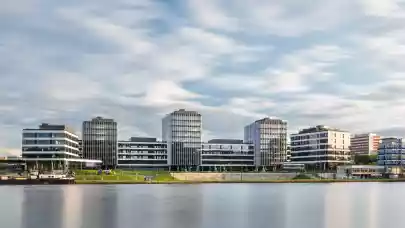
Slovakia’s economy surpassed expectations in H1 2023 with the automotive industry leading the charge. The industrial sector flourishes with robust take-up and diversified supply and there is also a continuous rise in rents in all submarkets. Resilient take-up but robust new supply caused rising vacancy, stabilized fit-out costs, rising rents and yields. Cushman & Wakefield published its Marketbeat Analysis for Q3 2023.
Although the rebound of the Slovak economy has not yet fully materialised, the economy performed above expectations in Q2, as the GDP grew by 1.5% y-o-y, the most in the last five quarters. Interestingly, the automotive industry has offset the decline in private consumption, exemplifying the sector's resilience and significant role in the nation's economy. The National Bank of Slovakia forecasted GDP growth for 2023 at 1.5% with a significant improvement of 2.7% in the next year. However, the country is grappling with a budgetary deficit, requiring austerity measures in the coming years, which could negatively impact the GDP. Future fiscal consolidation will depend on the strategies of the incoming government. Despite a decline in inflation, the figures don't factor in energy prices, with the state currently subsidising them and they will be reflected in inflation the next year as they are expected to align with market rates. However, we anticipate a faster-than-initially expected drop in inflation next year also due to a slowdown in food prices, projected to continue into H1 2024. Unemployment remained stable at 4% as of September, a figure that has been consistent since May.
Nonetheless, a slight uptick in unemployment is expected and real wage growth is not anticipated this year. In September 2023, the ECB raised key interest rates by 25 bps to 4.5%. This hike levelled prime office and industrial yields in Q3. The ECB announced no rate decreases until mid-2024 and combined with the expected yield increase in neighbouring countries and Western Europe creates upward pressure on yields.
Industrial market
The industrial sector in Slovakia remains on a strong footing, even amid seasonal fluctuations. This resilience is captured in Q3 robust take-up figures. Gross take up reached 169,900 sqm and net take-up stood at 120,400 sqm, representing increases of 23% and 10% respectively when compared to the five-year quarterly average. Alongside this, the vacancy rate fell by almost one percent to 2.92%, signalling persisting good market conditions. The automotive industry continues to be the main demand driver, accounting for over 50% of total take-up, followed by 3PL. Notably, there was a surge in demand for battery manufacturing this quarter, largely due to Volvo's new plant in Eastern Slovakia and KIA’s factory transition to battery production. Therefore, all indicators suggest a continuing trend and a strong Q4. This quarter, new supply totalled to 69,300 sqm, with almost one-third situated in Central Slovakia, further diversifying the geographical distribution of industrial spaces. Properties currently under construction account for 309,100 sqm, spread across 19 buildings with nearly half concentrated in Western Slovakia. Developers are exhibiting caution in speculative construction except for areas like Greater Bratislava, Trenčín, Žilina, and Eastern Slovakia, where available space is limited. Q3 net absorption was the highest this year, standing at 96,400 sqm, further attesting to the market's vitality.
In response to robust demand, land banks continue to be acquired for future pipeline projects, especially in areas with limited space availability like Greater Bratislava, Trenčín, Žilina, and Eastern Slovakia. Despite stabilized construction costs, prime rents have slightly increased to 4.9 €/sqm/month. This rise in rents—22.5% over the past 18 months—is partly mitigated by long-term leases exceeding five years, as required by landlords. Although prime yield in Q3 was stable at 6.25%, it remains under upward pressure. Slovakia's industrial segment is continuing to be attractive to both developers and tenants, particularly given its competitive headline rates and the country's significant role in Central and Eastern Europe's automotive sector. This has caught the attention of companies looking to relocate from Germany and China. The market also anticipates a larger number of ongoing transactions materialising by year-end, reaffirming its vitality. Both developers and clients are gradually concentrating on ESG factors, adopting more sustainable solutions such as photovoltaic panels and heat pumps.
Office market
Despite expectations of a market slowdown, the Bratislava office sector remains steadfast, evidenced by a 3% year-over-year increase in gross take-up, reaching 39,900 sqm, and net take-up of 25,000 sqm. Professional services lead in demand, accounting for nearly a quarter, followed by Consumer Goods and Pharma/Medical, each contributing over 15%. The public sector continues to have an important role as a possible source of demand for new office spaces (especially A and B categories). Tenant focus on certified buildings and carbon neutrality is intensifying, with rising demand for zero carbon/carbon-free buildings expected in the coming years. This quarter saw the addition of two A+ buildings: Pribinova 34 with 17,500 sqm and Pribinova 40 with 21,000 sqm. However, as they are only about 50% leased, they significantly contributed to the increase in the vacancy rate, which reached 13.82%, marking a 2% quarterly increase. Large corporations, particularly in IT, are continuing their downsizing efforts, although with diminished intensity. In contrast, legal firms are expanding, especially those corporations maintaining a traditional office-centric work model, but mostly to newer, high-end buildings. This divergence is widening the gap between A and B-class projects. Downsizing, rising vacancy and financing costs have led to a slowdown in planned developments, resulting in no new completions anticipated for 2024-2025. This provides an opportunity for the absorption of existing spaces. In the face of changing work modalities, relocations, and evolving workspace needs, the demand for well-thought-out workplace strategies is rising. In addition, fit-out costs have stabilized after a rapid increase over the past year. Although both prime and headline rents are gradually rising across all submarkets, current operational cost increases and intense market competition limit significant rent hikes. This competition is most fierce between A and B categories. However, only the A+ segment, which holds approximately a 17% market share, will be able to maintain its rents at prime levels, now standing at €18/sqm/month. The prime yield has increased to 6.25%, a quarter-on-quarter increase of 25 basis points, in line with continuous interest rate hikes. Further adjustments in yield are not ruled out in the coming quarters.
Retail market
Retail park development dominance and demand for larger paces Q3 revealed that challenges in filling small to medium-sized retail units persist across Slovakia, not just in Bratislava. On the other hand, larger spaces, particularly for fashion and discount stores, are in demand but location availability remains an issue. However, the quarter saw the opening of two new retail parks—Spektrum Retail Park in Rimavská Sobota (6,000 sqm) and OC Klokan in Chorvátsky Grob (3,700 sqm). Currently, 44,500 sqm of retail area is under construction, mainly in retail parks. In addition, another 46,700 sqm is planned for completion by the end of 2024, all of which are retail parks, confirming their dominant position in the scope of future retail development. As consumer sentiment improves, many shopping centres and retail parks reported higher revenues than last year, although inflationary pressures remain. With an eye on geopolitical uncertainties and an inflationary environment, several tenants are waiting for year-end results to decide whether to expand. TopShop, Dormeo, and Delimano have currently closed their operations and also suspended purchasing on their e-shops. On the other hand, eObuv and Modivo have opened their first stores of a new kind (showroom concept). Likewise, Lindt has opened its first store in Slovakia in Eurovea 2.
In Bratislava and regional cities, retail oversaturation remains a concern. Despite this, top-tier regional shopping centres are performing well. Retail parks are experiencing increased demand, driving a modest uptick in rents. The prime rent for retail parks has reached double digits in Q3 – €10/sqm/month, with future developments commanding asking rates between €11-12/sqm/month. Therefore, prime rent is projected to continue its upward trajectory in the coming quarters. As energy prices for the upcoming year are under negotiation, the currently low spot prices, compared to last year's highs, are expected to positively impact service charges. In terms of financial metrics, prime yields stand at 6.5% for the best-performing shopping centres and 7.25% for retail parks. Prime rent for shopping centres has remained steady at €65/sqm/month, with no signs of change on the horizon.



